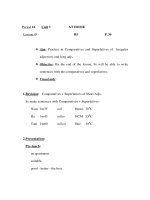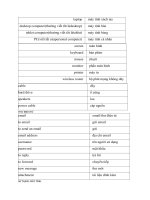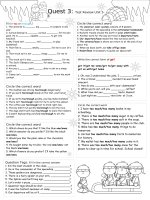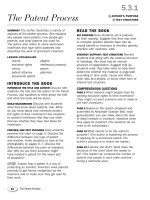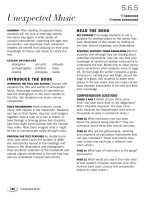3 6 5 jackie robinson (social studies)
Bạn đang xem bản rút gọn của tài liệu. Xem và tải ngay bản đầy đủ của tài liệu tại đây (5.18 MB, 14 trang )
Suggested levels for Guided Reading, DRA,™
Lexile,® and Reading Recovery™ are provided
in the Pearson Scott Foresman Leveling Guide.
Genre
Biography
Comprehension
Skills and Strategy
• Generalize
• Compare and
Contrast
• Predict
Biography
Text Features
•
•
•
•
Captions
Headings
Sidebar
Table of Contents
Scott Foresman Reading Street 3.6.5
ISBN 0-328-13411-2
ì<(sk$m)=bdeb d< +^-Ä-U-Ä-U
Jackie
Robinson
by Morgan Lloyd
Reader Response
Jackie
Robinson
1. What different forms of discrimination did
African American baseball players face?
2. Predict what might have happened if
Jackie Robinson had not agreed to play
for the Brooklyn Dodgers.
3. Some verbs can be made into nouns by
changing the ending. How can the verbs
discriminate and segregate be made into
nouns? What other words do you know
with the same suffix?
4. Make a time line of the major events in
Jackie Robinson’s life. Include both the
dates and the events.
Event
Date
by Morgan Lloyd
Editorial Offices: Glenview, Illinois • Needham, Massachusetts • New York, New York
Sales Offices: Needham, Massachusetts • Duluth, Georgia • Glenview, Illinois
Coppell, Texas • Ontario, California • Mesa, Arizona
CONTENTS
Introduction
The Early Years
Beginnings in Baseball
The Major Leagues
Jackie’s Legacy
Now Try This
4
6
11
15
19
22
Every effort has been made to secure permission and provide appropriate credit for
photographic material. The publisher deeply regrets any omission and pledges to
correct errors called to its attention in subsequent editions.
Unless otherwise acknowledged, all photographs are the property of Scott Foresman,
a division of Pearson Education.
Photo locators denoted as follows: Top (T), Center (C), Bottom (B), Left (L), Right (R),
Background (Bkgd)
Cover ©Bettmann/Corbis; 1 © Bettmann/Corbis; 4 (BL) © Lake County Museum/Corbis,
4 (BR) ©Bettmann/Corbis; 6 © Hulton Archive/Getty Images; 8 © Bettmann/Corbis; 9
©Bettmann/Corbis; 10 © Sporting News/Sporting News/Getty Images; p11 © Sporting
News/Sporting News/Getty Images; 13 © Bettmann/Corbis; 14 © Bettmann/Corbis; 15
©Bettmann/Corbis; 17 © Bettmann/Corbis; 18-19 © Bettmann/Corbis; 20 © Bettmann/
Corbis; p21 ©Bettmann/Corbis; 22 © Bettmann/Corbis; 23 (TR) © Bettmann/Corbis, 23
(TL) ©Bettmann/Corbis, 23 (BR) © Bettmann/Corbis
ISBN: 0-328-13411-2
Copyright © Pearson Education, Inc.
All Rights Reserved. Printed in the United States of America. This publication is
protected by Copyright, and permission should be obtained from the publisher
prior to any prohibited reproduction, storage in a retrieval system, or transmission
in any form by any means, electronic, mechanical, photocopying, recording, or
likewise. For information regarding permission(s), write to: Permissions Department,
Scott Foresman, 1900 East Lake Avenue, Glenview, Illinois 60025.
2 3 4 5 6 7 8 9 10 V0G1 14 13 12 11 10 09 08 07 06 05
3
Introduction
On April 15, 1947, Jackie Robinson
stepped out of the dugout at Ebbets Field
in Brooklyn, New York. The number 42 was
displayed proudly on his blue-and-white
jersey as he crossed the field to take his
place at first base.
It was Opening Day for the Brooklyn
Dodgers, and Jackie Robinson was about
to make history. For more than half
a century, no African American
player had played in the Major
Leagues. An invisible “color
barrier” had kept talented
African American
players out of
organized baseball.
4
Until 1947, professional baseball
was segregated. Only white players
could play Major League baseball,
where they had contracts, regular
schedules, and earned enough money
to make a living.
African American players were
restricted to the Negro Leagues or
foreign leagues in Mexico and Latin
America. Playing in these leagues,
they earned far less and had harder
schedules. Negro League teams had a
hard time traveling too. In the South,
racist laws known as Jim Crow laws
kept many hotels and restaurants
open to “whites only.” So African
American players often went without
meals or slept on their busses.
There were more than two dozen
teams in the Negro Leagues, and there
were hundreds of talented players.
But they were not allowed to play in
the Majors. Jackie Robinson changed
all that. But it wasn’t easy.
5
The Early Years
Jack Roosevelt Robinson was born
January 31, 1919, in Cairo, Georgia. Jackie
had four older siblings: Edgar, Frank,
Mack, and Willa Mae. His father was a
sharecropper for a white landowner in
Cairo, working hard on the land for little
pay. Jackie’s father grew tired of this way
of life, and when Jackie was only one year
old, his father left the family in search of
better work. He never returned, though, so
Mallie, Jackie’s mother, was left alone with
the five children.
The Robinson Family.
Jackie is second from left.
6
In 1920, when Jackie was just sixteen
months old, his mother packed up the
family and took a train to Pasadena,
California, where her brother lived. Mallie
soon found work doing laundry and
housekeeping. At first, the family lived
with Mallie’s brother, but as soon as they
could, the family moved into a house on
Pepper Street, in a neighborhood that was
entirely white.
Since Jackie’s mother had to work so
hard to support the family, there was no
one home to take care of Jackie. During
the day, he would go to school with his
sister Willa Mae. As he was still too young
for school, Jackie spent the day outside
in the sandbox, playing by himself. Even
with his mother working as hard as she
could, there was often not enough money
for food. Sometimes Mallie brought food
home from the wealthy houses where she
worked.
7
As a child, Jackie liked all kinds of sports
and games, and he loved to win. When he
was old enough to go to school, he quickly
realized that he was an excellent soccer
player. All of the other kids wanted Jackie
on their team and would give him extra
snacks to get him to play on their side.
In high school and junior college, Jackie
continued to shine in sports, receiving
many offers of scholarships from major
colleges. Because he wanted to stay
close to his mother and help support her,
Jackie decided to go to the University of
California at Los Angeles (UCLA).
Jackie’s older brother, Mack,
was also a talented athlete
who set track-and-field
records in high school and
at Pasadena Junior College.
In 1936, Mack qualified for
the U.S. Olympic team. He
ran with the famous sprinter
Jesse Owens. He won a silver
medal in the 200 meters,
finishing second behind
Owens.
8
Jackie was an all-around
athlete, excelling in
many sports.
At UCLA, Jackie competed in more
than half a dozen sports and reached
new levels of athletic achievement.
Jackie was the leading scorer in
basketball; he won a golf championship;
and he made it to the semifinals of the
National Negro Tennis Tournament.
He also won several swimming
championships, ran track, and played
baseball. But by far, his favorite sport
was football. With Jackie on the team,
UCLA was undefeated in 1939.
9
Beginnings in Baseball
Perhaps the most important thing that
happened to Jackie while he was at UCLA is
that he met Rachel Isum. Rachel and Jackie
became close friends, and in 1942, they
became engaged. Jackie did not graduate
from UCLA. He was anxious to earn money
to support his mother, and he felt that
because he was African American, even a
college degree would not guarantee him a
good job.
Not long after he left UCLA, Pearl
Harbor was attacked, and the United States
entered World War II. Jackie was drafted
and served two years in the army. Since he
had an injury to his ankle from football,
Jackie was never sent into combat.
10
When he left the army in 1944, Jackie
was twenty-five years old. A friend he had
met in the army told him that the Kansas
City Monarchs (a Negro team)
were looking for players.
Jackie wrote a letter to
the coach and was invited
to the spring tryouts.
Soon after the tryouts,
Jackie signed a contract for
the 1945 season. Though
he loved playing, Jackie
grew tired of the
daily struggles to find
restaurants and hotels
that would serve
African Americans.
He could not live
with that kind of
discrimination, and
Jackie began to
think about leaving
baseball altogether.
Jackie played for the
Kansas City Monarchs.
11
Little did Jackie know that someone
was watching him play. That someone
was Branch Rickey, the president of the
Brooklyn Dodgers. He had wanted to
break the color barrier in Major League
baseball for some time but had never been
successful.
The new head of Major League baseball
was open to the idea. Still, Rickey was
cautious. He did not go public with his
plans to sign an African American player
but instead pretended that he had plans to
start a new African American team, to be
called the Brooklyn Brown Dodgers.
Under this guise, he sent scouts around
the country looking for talented African
American players. In August of 1945,
one of these scouts approached Jackie
Robinson, inviting him to Brooklyn to meet
with Branch Rickey.
Rickey knew that Jackie had both the
talent and the strength to play in the
Major Leagues. In their meeting,
12
Rickey told Jackie that he was not
recruiting him for the Brooklyn Brown
Dodgers. He wanted Jackie to play in the
Majors, for the Brooklyn Dodgers, and he
would start him with their farm team, the
Montreal Royals. Even as Rickey described
the horrible things players and fans might
do or say, Jackie knew that he wanted to
try. More than anything, he wanted to
open the door for all players, regardless of
color, to play Major League baseball.
Jackie signed a contract
with the Montreal
Royals, the farm team
for the Brooklyn
Dodgers.
13
Before he began his training with the
Royals, Jackie took a few months off.
During this time, Jackie and Rachel Isum
were married, and the two of them traveled
together to Florida when it was time for
training camp to begin. Throughout Jackie’s
career in baseball, Rachel was a constant
Jackie and Rachel were married before his Major League
support.
Baseball career began.
14
The Major Leagues
Jackie’s Montreal Royals teammates
eventually warmed up to his presence. In
some places, the team met record crowds
and enthusiastic fans, but in others, Jackie
faced terrible insults from both players
and fans.
Even in the face of such
adversity, Jackie played incredible
baseball. The Montreal Royals won
the Little World Series, thanks in
good part to Jackie. That thrill was
surpassed only by the birth of his
first son, Jack Roosevelt Robinson,
Jr., on November 18, 1946.
15
The following spring, just five days
before the season opener, Branch Rickey
announced that Jackie Robinson would be
playing for the Brooklyn Dodgers. At first,
there was serious opposition. Several of
the Dodgers’ players threatened to strike,
while others asked to be traded. On other
teams, players threatened to strike rather
than play against an African American
man. Finally, the president of the National
League issued a statement saying that he
did not care if half the league went on
strike. Those who did would suffer the
consequences. “This is the United States of
America,” he said, “and one citizen has
as much right to play as another.”
16
But playing was not easy. Opposing
players and sometimes spectators in
the stands hurled insults at Jackie. He
knew that if he stood up for himself,
if he started answering back, he might
risk ruining everything. If a fight broke
out, it would end the chance for other
African Americans to play in the Majors.
By standing firm and not descending to
the level of his attackers, Jackie won the
respect of his team and many fans across
the country.
Despite protests, Jackie joined the Brooklyn
Dodgers, breaking the “color barrier.”
17
Jackie proved that the fans did not care
if a player was black or white, as long as he
was a winner. And Jackie was a winner! He
was famous for sacrifice bunts and stealing
bases. That year, Jackie had more stolen
bases than any other player in the League,
and he came in second for total runs
scored. That year Jackie was named
Rookie of the Year. He went
on to play ten seasons with
the Brooklyn Dodgers.
During that time, the
team won six pennants
and beat the New York Yankees to win the
World Series in 1955. Jackie also won the
hearts of millions of fans.
Jackie’s Legacy
Jackie’s success paved the way for
other African American players to join
the Majors. One by one, other teams
followed suit. By 1959, twelve years after
Jackie Robinson broke the color barrier,
every team in Major League baseball had
at least one African American player. In
1962, Jackie Robinson was the first African
American to be elected to the Baseball
Hall of Fame. But Jackie’s commitment to
fighting for equality and civil rights did not
end with the integration of baseball.
The fans turned out in record numbers to see Jackie
and the Dodgers play. In this 1949 game, Jackie slid
hard to steal home but was tagged out by Rube
Walker of the Chicago Cubs.
18
19
Though he will always be remembered
as the first African American to play in
the Major Leagues, baseball was just one
part of Jackie’s legacy. Throughout his life,
Jackie fought for civil rights, wanting to
improve the lives of African Americans and
others.
After he retired from baseball, Jackie
and his wife, Rachel, participated in voter
registration drives to register African
American voters. They raised money
to support Martin Luther King, Jr.’s,
organization, the Southern Christian
Leadership Conference (SCLC). Jackie
spoke out against segregation and tried
to get other athletes involved in the civil
rights movement. He once said, “A life is
not important except for the impact it has
on other lives.”
Jackie’s life was
dedicated to
service.
20
Jackie continued to work for civil rights for
the rest of his life.
Late in his life, Jackie struggled with
his health. Doctors diagnosed him with
diabetes. By the time he was in his late
forties, he had started to lose his sight. On
October 24, 1972, Jackie suffered a heart
attack and died. He was only fifty-three
years old.
Jackie’s life was an example of the
importance of standing up for what you
believe in. He never stopped working to
help others. Even today, his strength and
accomplishments are an inspiration to
us all.
21
Now Try This
There were many other talented players
in the Negro Leagues. Many of them never
got a chance to play in the Majors. Others
did and were even inducted into the Hall
of Fame.
t o D o I t!
Here’s How
Find out more about some of these
amazing players and the teams for which
they played.
• Use a library or the Internet to find
information.
• Write a brief report or a biography of a
player.
• Share what you learn with a parent or
friend.
From left:
Jackie Robinson,
George Crowe, Joe
Black, Sam Jethroe,
Roy Campanella,
and Bill Bruton.
22
Hank Aaron
Willie Mays
Ernie Banks
23
Glossary
adversity n.
hostile opposition
or challenging
circumstances
descending v. going
down; lowering
oneself
discrimination n.
unfair treatment
based on prejudice
guise n. a false
appearance (as in
disguise)
legacy n. the lasting
contributions of a
person or event
scholarships n. gifts
of money or support
to help a student
in college or other
studies
24
Reader Response
segregated adj.
requiring separate
areas or facilities for
people of different
races
sharecropper n.
a farmer who does
not own the land he
lives or works on, but
instead rents it from
the owner and pays
with a portion of the
crops produced
strike v. to refuse
to work as a way of
protesting
1. What different forms of discrimination did
African American baseball players face?
2. Predict what might have happened if
Jackie Robinson had not agreed to play
for the Brooklyn Dodgers.
3. Some verbs can be made into nouns by
changing the ending. How can the verbs
discriminate and segregate be made into
nouns? What other words do you know
with the same suffix?
4. Make a time line of the major events in
Jackie Robinson’s life. Include both the
dates and the events.
Event
Date

